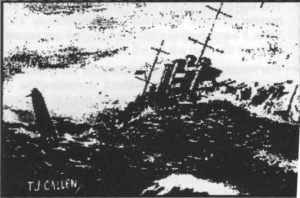- Author
- Gregory, Mackenzie J.
- Subjects
- Ship histories and stories, WWII operations
- Tags
-
- RAN Ships
- HMAS Australia II
- Publication
- March 1997 edition of the Naval Historical Review (all rights reserved)
On Monday 28th October 1940. I was serving as an eighteen year old Midshipman in HMAS “Australia”, and 8inch gun cruiser. At that time, we had arrived on the Clyde at Greenock, Scotland, only two days earlier, after passage from Gibraltar.
What a contrast we found the weather from our recent time in the tropics; cold days and even colder nights, and rough Atlantic weather to cope with at sea.
We were ordered to sea that afternoon, to join a search for a German merchant raider, reported operating against our shipping, keeping open the life line from the United States. The convoys were necessary for Britain’s survival, bringing food, oil, etc., to allow the continued struggle against Germany by Britain and her dominions, Australia, Canada and New Zealand. In 1940, this small group alone represented the free world against the might of the Third Reich.
The “Australia” and her crew were here to play our own small part in those very dark days. Notwithstanding the growing U Boat menace, and the wide geographic area covered by German aircraft, our merchant ships and those of many neutral countries were still at sea; many ships survived to arrive at their destinations on the West coast of the United Kingdom.
As Tuesday dawned, we learned of a coastal command Sunderland flying boat which had made a forced landing in the Atlantic ocean West of the Hebrides. Our task was to try and locate this R.A.F. aircraft. There was a gale blowing, the barometer had fallen, visibility was poor, and finding the Sunderland in such adverse conditions appeared difficult, if not unlikely.
The ship was running with an extremely rough sea, rolling heavily.
During the afternoon, the flying boat kept up transmissions on her radio so that we could use our direction finding equipment to locate her, and then search along this D/F bearing. Just after noon we received a message from the flying boat: “Hurry up – am breaking up“.
As we approached closer to her estimated position we made smoke at intervals, hoping the crew could spot us.
Visibility was now very low, and we had increase speed to 26 knots in an attempt to arrive before it was too late – but the ship was making very heavy weather of the prevailing conditions.
A huge sea was running and our heavy cruiser, which picked up on the crest of each wave then surfed down it the next trough, and the wind was blowing a gale.

At 1435 the Sunderland was sighted ahead, her tail occasionally visible above the huge waves – a crew member constantly operating a flashing light to guide us.
When only half a mile from the boat, one of her floats dropped off; a moment later, an enormous wave picked the Sunderland and flipped it completely over on it’s back.
We could see only one crew member perched on the upturned boat.
We now approached from upwind drifting down onto the wreckage, ropes having been prepared over our starboard side. Scrambling nets, and jumping ladders were also placed over the starboard side.
We suddenly sighted a group of airmen in the water with life jackets on – the ship drifted towards them and rescue ropes were passed.
However, the rough and icy Atlantic prevented the airmen from securing a rope to themselves – they were too exhausted to tie a knot – salvation at hand, but were the elements going to win after all? “Australia” was rolling heavily, one minute the starboard side would be feet under water, then a heavy roll would reverse to port, and the starboard side would be well clear of the water. Given the force of the wind, and the state of the sea the only way to pluck the survivors from the Atlantic was to send several officers and sailors over the side with bowlines to secure to the airmen. These were led and encouraged by the Commander J.M. (“Jamie– or “Black Jack”) Armstrong RAN. One by one they had to be hauled on board, With the ship rolling heavily, the airmen’s heavy water logged gear made for a long and difficult task. Persistence and sheer bravery from those over the side securing each airman finally triumphed. Nine of the crew of thirteen were finally on board, suffering from exposure, but they would be safe after time spent in the sick bay.




